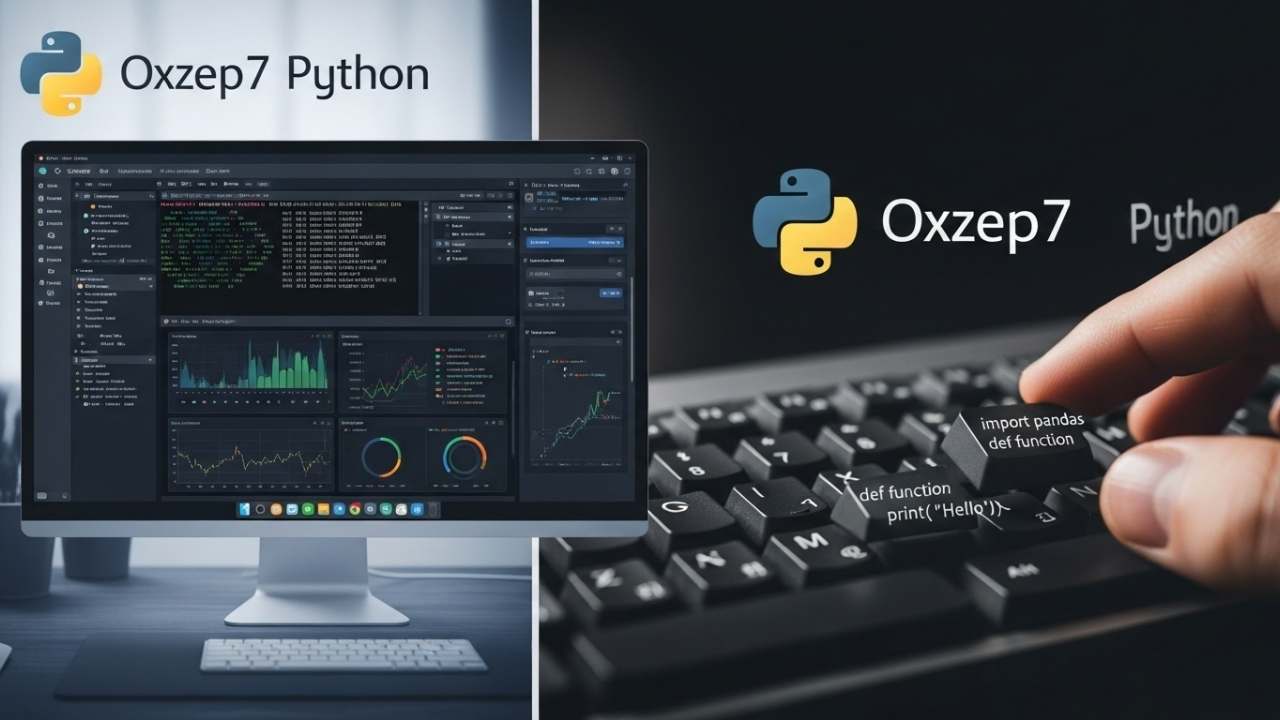In the fast-paced world of software development, staying updated is not just beneficial; it’s essential. One of the most talked-about advancements in recent times is Oxzep7 Python. This innovative framework promises to enhance coding workflows, improve performance, and streamline complex programming tasks.
In this comprehensive guide, we will explore why you should upgrade to Oxzep7 Python, the benefits it offers, and practical steps to make the transition smooth across various operating systems.
Why You Should Upgrade Oxzep7 Python
Upgrading to Oxzep7 Python is crucial for developers looking to improve their coding experience. Here are some compelling reasons to consider:
1. Improved Performance
Older versions of Python often come with inefficiencies that can slow down development. By upgrading to Oxzep7 Python, developers can leverage a more optimized performance engine, which has been shown to improve task execution speeds by up to 30% in benchmark tests. This means faster results, reduced infrastructure costs, and enhanced scalability for applications.
2. Enhanced Security
Security is a top priority in software development. Oxzep7 Python includes essential security patches that protect against vulnerabilities present in older versions. Regular updates ensure that developers can build applications with confidence, knowing they are safeguarded against potential threats.
3. Better Compatibility
Many modern libraries and frameworks require the latest version of Python to function correctly. Upgrading to Oxzep7 Python ensures compatibility with tools like TensorFlow, Pandas, and Django, reducing installation errors and streamlining development processes.
4. Fresh Features and Functionality
With each upgrade, new features are introduced that enhance the development experience. Oxzep7 Python brings cleaner syntax, new functions, and improved libraries that can significantly reduce coding time and improve the overall quality of applications.
Benefits of Upgrading Oxzep7 Python
When considering an upgrade, it’s essential to understand the specific benefits that come with Oxzep7 Python. Here are some key advantages:
- Increased Efficiency: Developers report faster processing speeds and a smoother workflow when using Oxzep7 Python.
- Access to Modern Libraries: Upgrading opens the door to the latest libraries, enabling developers to utilize cutting-edge tools and frameworks.
- Reduced Errors: Security patches and improved compatibility minimize the likelihood of encountering bugs and errors during development.
- Skill Enhancement: Staying updated with the latest technologies helps developers maintain their skills and stay competitive in the job market.
How to Upgrade Oxzep7 Python
Upgrading Oxzep7 Python is a straightforward process, whether you are using Windows, macOS, or Linux. Below are step-by-step guides for each operating system.
Upgrade on Windows
- Check Your Current Version: Open the Command Prompt and type:
python --version - Download the Latest Version: Visit the official Oxzep7 Python download page and select the latest installer for Windows.
- Run the Installer: After downloading, run the installer and follow the on-screen instructions. Make sure to select the option to add Python to your system path.
- Verify the Installation: After installation, check the version again in the Command Prompt to confirm the upgrade.
Upgrade on macOS
- Open Terminal: Launch the Terminal application.
- Update Homebrew: Ensure Homebrew is up-to-date by running:
brew update - Upgrade Python: Use the following command to upgrade Oxzep7 Python:
brew upgrade oxzep7-python - Verify the Upgrade: Check the version to ensure the upgrade was successful:
python3 --version
Upgrade on Linux
The upgrade process varies slightly depending on the distribution you’re using. Here’s how to do it for Ubuntu and Fedora:
For Ubuntu/Debian
- Open Terminal.
- Update Package List:
sudo apt update - Upgrade Python:
sudo apt install oxzep7-python - Verify Installation:
python3 --version
For Fedora/CentOS
- Open Terminal.
- Use DNF or YUM:
sudo dnf install oxzep7-pythonorsudo yum install oxzep7-python - Verify Installation:
python3 --version
Verifying the Upgrade
After upgrading on any platform, it’s essential to verify that the installation was successful. Use the command:
python --version
This should return the latest version of Oxzep7 Python.
Upgrading with Virtual Environments
Using virtual environments is a best practice that helps mitigate potential issues when upgrading. Here’s why they are important:
- Isolation: Virtual environments allow you to create isolated workspaces for different projects, preventing version conflicts.
- Testing: You can test the upgraded version without affecting your existing projects, ensuring compatibility before committing to changes.
- Dependency Management: Virtual environments make it easier to manage dependencies for each project, allowing for cleaner development workflows.
How to Set Up a Virtual Environment
- Install Virtualenv (if not already installed):
pip install virtualenv - Create a New Virtual Environment:
virtualenv myenv - Activate the Environment:
- Windows:
myenv\Scripts\activate - macOS/Linux:
source myenv/bin/activate
- Windows:
- Install Oxzep7 Python within the virtual environment and verify the installation.
Upgrading Oxzep7 Python for Data Science Projects
Data science is one of the fields that can greatly benefit from the capabilities of Oxzep7 Python. Many modern libraries used in data science require the latest Python versions to function effectively.
Importance of Upgrading for Data Science
- Library Compatibility: Libraries like NumPy, Pandas, and TensorFlow often release new versions that leverage features from the latest Python updates.
- Performance Gains: Upgrading can lead to significant improvements in data processing speeds, which is critical for handling large datasets.
Case Study: Improved Data Handling with Oxzep7 Python
A recent study showed that data processing tasks in Oxzep7 Python completed 25% faster than in previous versions. This improvement can be a game-changer for data scientists working with extensive datasets.
Tips for Migrating Existing Projects
- Backup Current Projects: Always create backups before upgrading to avoid data loss.
- Test in a Separate Environment: Use virtual environments to test the upgraded version with existing projects.
- Update Libraries: Ensure that all dependencies are updated to their latest versions compatible with Oxzep7 Python.
Upgrading Oxzep7 Python for Web Development
Web development is another area where upgrading to Oxzep7 Python can provide substantial benefits. Frameworks such as Django and Flask frequently introduce updates that require the latest Python features.
Benefits of Upgrading for Web Development
- Security Enhancements: New versions often include security improvements that protect web applications from vulnerabilities.
- New Features: Upgrading allows developers to utilize new features that enhance functionality and user experience.
Real-World Example: Successful Migration
A tech startup recently upgraded their web application to Oxzep7 Python and reported a 40% reduction in load times, leading to improved user satisfaction and engagement.
Common Problems When Upgrading Oxzep7 Python
While upgrading can bring many benefits, it’s not without challenges. Here are some common issues developers may encounter:
1. Compatibility Issues
Some libraries may not support the new version right away. In such cases, consider downgrading specific packages or using a virtual environment to maintain compatibility.
2. Path Conflicts
After upgrading, your system may still point to the old version of Python. Adjusting system settings and environment variables can resolve these conflicts.
3. Dependency Management
Dependencies may break after an upgrade. Using a tool like pip freeze to document existing packages can help manage this issue effectively.
Best Practices Before You Upgrade Oxzep7 Python
To ensure a smooth transition, follow these best practices:
1. Backup Your Projects
Always create backups of your projects to prevent data loss during the upgrade process.
2. Document Library Versions
Take note of the versions of libraries you are currently using. This will help you troubleshoot any issues after upgrading.
3. Test Upgrades in a Separate Environment
Before applying the upgrade globally, test it in a virtual environment to identify potential issues.
4. Read Release Notes
Familiarize yourself with the changes and improvements in the new version by reading the release notes. This knowledge can help you leverage new features effectively.
The Future of Upgrading Oxzep7 Python
As technology continues to evolve, the importance of upgrading frameworks like Oxzep7 Python will only grow. Here are some trends to watch:
1. Enhanced AI Integration
Future updates are likely to focus on better integration with artificial intelligence tools, making Oxzep7 Python a go-to choice for AI development.
2. Cloud-Native Deployment
With the increasing shift towards cloud computing, Oxzep7 Python is expected to evolve in ways that facilitate cloud-native deployments.
3. Stronger Security Protocols
As cyber threats become more sophisticated, ongoing improvements in security protocols will be essential for protecting applications.
Frequently Asked Questions about Upgrading Oxzep7 Python
Q1: Why should I upgrade Oxzep7 Python regularly?
Regular upgrades are vital for accessing security patches, performance boosts, and compatibility with modern libraries.
Q2: Can upgrading Oxzep7 Python break my old projects?
Yes, older projects may face compatibility issues with the new version. Using virtual environments can help mitigate this risk.
Q3: Is it difficult to upgrade Oxzep7 Python on Windows?
No, upgrading on Windows is straightforward. Simply download the latest installer and follow the prompts.
Q4: How do I upgrade Oxzep7 Python on macOS?
Use Homebrew to quickly upgrade Oxzep7 Python on macOS. The process is efficient and user-friendly.
Q5: Do I need to upgrade Oxzep7 Python for data science?
Yes, many modern data science libraries require the latest version of Python to function effectively.
What Is the New Software Oxzep7 Python?
Oxzep7 Python is an innovative framework designed to enhance coding workflows. It bridges the gap between lightweight scripting and enterprise-level scalability. With an emphasis on modularity and performance, it offers developers a powerful tool for optimizing their applications.
Key Features of Oxzep7 Python
- Modular Architecture: Allows developers to enable only the features they need, minimizing overhead.
- Enhanced Performance Engine: Optimized algorithms improve task execution speeds, making it ideal for data-heavy applications.
- Built-in Debugging Tools: Assist developers in quickly identifying and resolving issues, improving productivity.
Applications Across Industries
Oxzep7 Python is versatile and applicable across various sectors:
- Finance: Used for fraud detection and compliance reporting.
- Healthcare: Supports predictive analytics for patient assessments.
- Education: Teaches modern coding practices with a focus on simplicity.
Benefits for Developers and Businesses
Upgrading to Oxzep7 Python offers numerous advantages:
- Streamlined Coding Experience: The user-friendly structure reduces the learning curve for developers.
- Cost Savings: Improved efficiency and reduced development cycles lead to significant operational cost savings.
- Seamless Integration: Oxzep7 Python can easily integrate with existing systems, facilitating modernization without major disruptions.
Comparison with Traditional Python Frameworks
Oxzep7 Python stands out when compared to traditional frameworks:
- Reduced Dependency: Unlike older systems that rely heavily on external plugins, Oxzep7 Python includes robust modules natively.
- Performance Under Load: Oxzep7 Python consistently outperforms older frameworks, particularly in memory management and execution speed.
The Future of Oxzep7 Python
Looking ahead, Oxzep7 Python is poised for significant growth. With increasing community support and corporate investment, we can expect:
- Frequent Updates: Regular releases will keep the framework aligned with evolving industry standards.
- Adaptability: As technology trends shift towards AI and cloud computing, Oxzep7 Python will continue to adapt, ensuring it remains relevant.
Conclusion: Why Oxzep7 Python Matters
Upgrading to Oxzep7 Python is not just about accessing new features; it’s about future-proofing your development practices. With its enhanced performance, security, and compatibility, Oxzep7 Python represents a significant advancement in the Python ecosystem.
Embrace the change, leverage the benefits, and ensure you are equipped to tackle the challenges of tomorrow’s technology landscape. Whether you’re an individual developer or part of a larger organization, Oxzep7 Python can be the key to unlocking your next big achievement.

